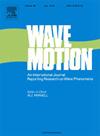Bucking and free vibration characteristics of smart hybrid sandwich plate via spatial state-space approach
IF 2.1
3区 物理与天体物理
Q2 ACOUSTICS
引用次数: 0
Abstract
While carbon nanotubes (CNT)- and graphene nanoplatelets (GNPs)-reinforced composites have been widely studied, hybrid nanocomposites are less explored. Polyurethane (PU) foams, valued for their low density and cost-effectiveness, face mechanical limitations, prompting nanoparticle reinforcement. This study investigates, for the first time, the buckling and vibration properties of PU matrices reinforced with multi-walled carbon nanotubes (MWCNTs), GNPs, and their hybrid combinations. This hybrid composite plate integrates two layers of piezoelectric sensors and actuators. The dynamics behavior of the system is modeled using linear three-dimensional piezo-elasticity theory. Through dual transformation pairs, the equations are converted into two decoupled, lower-order spatial state-space systems that describe both the plate's planar and transverse mechanical behaviors. Additionally, various parametric studies are conducted for the first time to explore the impacts of different ratios of MWCNT:GNP, different flake sizes of GNP, MWCNT aspect ratios, weight fractions of nanofillers, reinforced patterns, dimension ratios of the plate, electrical boundary conditions, and various boundary conditions for the edge of the plate on the natural frequency and buckling properties of hybrid smart composites. The results show that natural frequency and buckling load in PU nanocomposites rise with nanofiller weight fraction, peaking with FG-GNP24 at 1.0 wt% featuring 3.5 % and 6.2 % gains for frequency and buckling, respectively. Hybrid MWCNT-GNP systems excel at specific ratios: 5:1 (MWCNT-GNP1.5) surpasses single fillers, while 1:1 (MWCNT-GNP5) performs best at 0.25–0.5 wt%. Open-circuit piezoelectric configurations outperform closed-circuit. X-O nanofiller patterns optimize frequency in MWCNT-GNP24 composites (8:2, 5:1 ratios), while uniform distributions maximize buckling resistance.
基于空间状态-空间方法的智能混合夹层板屈曲和自由振动特性
虽然碳纳米管(CNT)和石墨烯纳米片(GNPs)增强复合材料已经被广泛研究,但混合纳米复合材料的探索较少。聚氨酯(PU)泡沫,因其低密度和成本效益而受到重视,面临机械限制,促使纳米颗粒增强。本研究首次研究了多壁碳纳米管(MWCNTs)、GNPs及其混杂组合增强PU基体的屈曲和振动特性。这种混合复合板集成了两层压电传感器和致动器。采用线性三维压电弹性理论对系统的动力学行为进行了建模。通过对偶变换对,将方程转化为两个解耦的低阶空间状态-空间系统,描述板的平面和横向力学行为。此外,还首次进行了各种参数研究,探讨了不同比例的MWCNT:GNP、不同片状GNP尺寸、MWCNT长径比、纳米填料的重量分数、增强模式、板的尺寸比、电边界条件以及板边缘的各种边界条件对混合智能复合材料固有频率和屈曲性能的影响。结果表明,PU纳米复合材料的固有频率和屈曲载荷随纳米填料质量分数的增加而增加,FG-GNP24在1.0 wt%时达到峰值,频率和屈曲载荷分别增加3.5%和6.2%。混合MWCNT-GNP体系在特定比例下表现优异:5:1 (MWCNT-GNP1.5)优于单一填料,而1:1 (MWCNT-GNP5)在0.25-0.5 wt%时表现最佳。开路压电结构优于闭合电路。X-O纳米填料模式优化了MWCNT-GNP24复合材料的频率(8:2,5:1),而均匀分布最大化了抗屈曲能力。
本文章由计算机程序翻译,如有差异,请以英文原文为准。
求助全文
约1分钟内获得全文
求助全文
来源期刊

Wave Motion
物理-力学
CiteScore
4.10
自引率
8.30%
发文量
118
审稿时长
3 months
期刊介绍:
Wave Motion is devoted to the cross fertilization of ideas, and to stimulating interaction between workers in various research areas in which wave propagation phenomena play a dominant role. The description and analysis of wave propagation phenomena provides a unifying thread connecting diverse areas of engineering and the physical sciences such as acoustics, optics, geophysics, seismology, electromagnetic theory, solid and fluid mechanics.
The journal publishes papers on analytical, numerical and experimental methods. Papers that address fundamentally new topics in wave phenomena or develop wave propagation methods for solving direct and inverse problems are of interest to the journal.
 求助内容:
求助内容: 应助结果提醒方式:
应助结果提醒方式:


